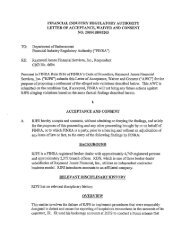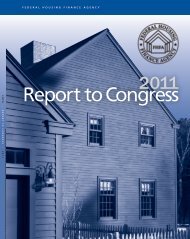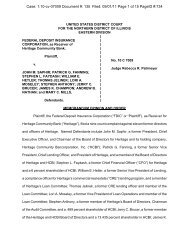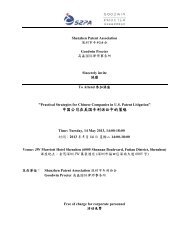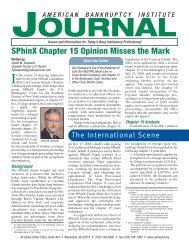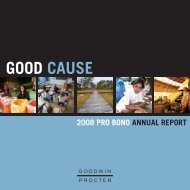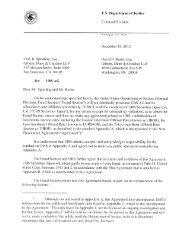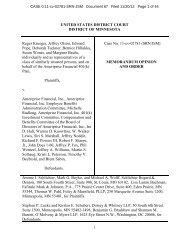FDIC as Receiver for City Bank vs. Conrad D. Hanson and ...
FDIC as Receiver for City Bank vs. Conrad D. Hanson and ...
FDIC as Receiver for City Bank vs. Conrad D. Hanson and ...
You also want an ePaper? Increase the reach of your titles
YUMPU automatically turns print PDFs into web optimized ePapers that Google loves.
C<strong>as</strong>e 2:13-cv-00671 Document 1 Filed 04/15/13 Page 48 of 97<br />
1<br />
2<br />
3<br />
4<br />
5<br />
6<br />
7<br />
8<br />
9<br />
10<br />
11<br />
12<br />
13<br />
14<br />
15<br />
16<br />
17<br />
18<br />
19<br />
20<br />
21<br />
22<br />
23<br />
24<br />
25<br />
26<br />
27<br />
2008 Loan Policy stressed the importance of liquidity in the composition<br />
of net worth. The Loan Memo showed that <strong>City</strong> <strong>Bank</strong>'s loan<br />
commitments to Guarantors G-2 <strong>and</strong> G-3's related entities plus the<br />
guarantors' personal liabilities totaled $23,035,200. The guarantors' <strong>and</strong><br />
borrower's combined c<strong>as</strong>h amounted to only 1.6 percent of this total<br />
amount of loan commitments <strong>and</strong> debt. Although the guarantors' <strong>as</strong>sets<br />
were listed at $20,312,400, 98.4 percent or $19,985,000 of that amount<br />
w<strong>as</strong> illiquid real estate holdings. When Defendants approved the<br />
Borrower G (II) Loan, the Real Estate Bubble had burst, <strong>and</strong> the<br />
guarantors had insufficient liquid <strong>as</strong>sets to repay the Borrower G (II)<br />
Loan.<br />
d. Failed to consider or knew of <strong>and</strong> disregarded the LTV ratio limit<br />
violation of the Borrower G (II) Loan. The <strong>Bank</strong>'s January 9, 2008 Loan<br />
Policy provided that, <strong>for</strong> purposes of the LTV ratio, "Value shall be<br />
defined <strong>as</strong> the lesser of appraised value or purch<strong>as</strong>e price (cost)." The<br />
Loan Policy further provided that the LTV ratio limit <strong>for</strong> residential<br />
construction loans w<strong>as</strong> 80 percent, which w<strong>as</strong> the same <strong>as</strong> the supervisory<br />
LTV ratio limit <strong>for</strong> multi-family residential construction loans. Given the<br />
loan amount of $3,592,000 <strong>and</strong> the estimated aggregate cost of the<br />
construction project of $3,521,570, the LTV ratio of the Borrower G (II)<br />
Loan w<strong>as</strong> 102 percent. This LTV ratio violated the Loan Policy's limit<br />
<strong>and</strong> the supervisory limit.<br />
e. Failed to en<strong>for</strong>ce or require compliance with the Loan Policy's debt-toworth<br />
limit of 4 to 1. The Loan Memo showed that Borrower G had<br />
liabilities of $6,626,699 <strong>and</strong> a net worth of $684,347. Borrower G's debtto-worth<br />
ratio w<strong>as</strong> 9.7 to 1, which exceeded the Loan Policy's limit.<br />
142. In or about March 2009, Borrower G defaulted on the loan.<br />
COMPLAINT - Page 48<br />
ATER WYNNE LLP<br />
1652284/1/SKB/105030-0018 601 UNION STREET, SUITE 1501<br />
SEATTLE, WA 98101-3981<br />
(206) 623-4711



